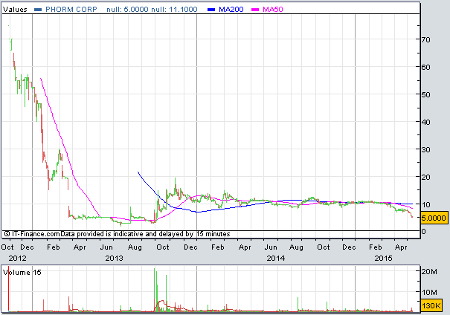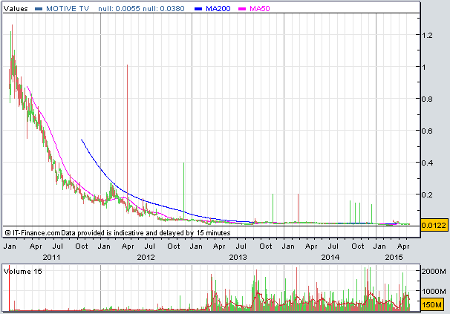AIM's most notorious money pits
15th May 2015 16:14
by Andrew Hore from interactive investor
Share on
It is always disappointing when a company that appears to have a potentially good business cannot raise cash to keep going, but it is even more bemusing when companies which have never shown much sign of achieving success can continually tap the market for millions of pounds despite being money pits.
Two examples of the latter are internet personalisation technology provider and digital TV technology company . They have tapped investors for money on a regular basis, at reducing share prices, and are valued at less than the money they have raised.
When it comes to pharma and cutting edge technology developers it is understandable that it can take years and years - and many ups and downs - to develop a product. At times, persuading customers to buy a product can be a long process. However, in other cases there seem to be companies which are never quite in the right place at the right time. So, even if there is demand for a product or service it never warrants the millions poured into its development.
Phorm
Singapore-based Phorm is beginning to grow its revenues, but from a very low base, and moving into new markets will help to accelerate growth. Customers include internet service providers, which can generate revenues from their data, while web publishers can generate more income from their advertising space. Advertisers can be provided with more cost-effective advertising opportunities.
Phorm is involved in an enormous online advertising market, but revenues were still modest at $1.58 million in 2014 and that is a significant improvement on previous years. However, this is a fraction of the bloated cost base, which is being reduced, but even quadrupled revenues would barely cover R&D spending, which has been running at around $6 million-$7 million a year. This is why cash flows out of the company so rapidly.
Phorm has moved into the US market so there is scope for rapid growth, but it is difficult to see the company reaching breakeven for a few years. That means that it will continue to require cash from investors.
Between 2004 and 2013, Phorm generated total revenues of just over $11 million, although this includes four years with no revenues. However, total directors' remuneration over the same period was nearly $11.8 million. Phorm boss Kent Ertugrul received just over half of that, although it is difficult to be exact because in 2008 he was not the highest paid director due to a former director receiving a large pay off. Even excluding 2008, Kent Ertugrul earned $5.74 million and the 2008 payment is likely to take him over $6 million - he was paid $0.63 million in 2007 and $0.74 million in 2009.

(click to enlarge)
More importantly, between 2003 and June 2014, Phorm raised $265.2 million through share issues. This figure is taken from the cash flow statements in the relevant accounts. Taking an exchange rate of $1.58 to the pound this equates to £168 million. Since the end of June 2014, a further £21.1 million has been raised.
Although the latest fundraising of £6 million was done at 8p a share, which is double the 4p a share at which £5.2 million was raised in April 2013, it is still a lower price than the other four fundraisings since last June, which range from 9p a share to 11p a share, and much lower than the 170p placing price in 2010. Go back another couple of years and the placing price was 450p.
At 5.125p a share, Phorm is valued at £43.2 million, which is less than one-quarter of the money raised in fewer than thirteen years. It is also barely twice the amount of money raised in less than 12 months.
Back in July 2010, when Phorm raised £2 million at 170p a share, the number of shares increased to 18.48 million. Five years later, there are 843.8 million shares in issue. This indicates the enormous dilution of long-term shareholders in the company, particularly as the cash raisings have been via placings where not all existing shareholders would have been able to participate. Given the share price performance, that is probably a good thing.
Motive TV
Motive TV was originally a TV programme producer and its programmes included BBC3 comedy How Not to Live Your Life - perhaps surprisingly not about investment in Motive TV. However, management decided that the company would be better off focusing on the digital terrestrial television technology opportunity and sold off most of the production companies. One TV production company has been retained, which means it is impossible to know how much the technology business generates in revenues because it is not split out, although its revenues did grow by 44% in 2013. In 2013, group revenues improved from £1.09 million to £1.17 million.
It can be difficult to find out exactly what the share price is because many websites do not publish share prices to more than two decimal places. It may have seemed strange that a company with a share price of less than 0.01p a share decided to go for a five-for-one consolidation earlier this year rather than a more substantial consolidation. Subsequent events, with the current share price not significantly higher than it was prior to the consolidation, show why this was done.
When a company is in a weak financial position at the time of a share consolidation the consolidated share price will fall back. That is because a loss-making, cash hungry business has little going for it when it comes to holding up a share price. If Motive TV had undertaken a more substantial consolidation there is a danger that the share price would have fallen even further.
At the current share price of 0.0125p, Motive TV is valued at £2.11 million. To put this in perspective, between 2010 and June 2014, Motive TV raised a total of £7.8 million. Since then, New York fund Bergen has converted loan notes valued at £1.64m into shares and Motive TV has raised a further £1 million at 0.015p - post consolidation. That means that Motive TV is not only valued at around one-fifth of the money raised in less than six years, including those converted loan notes, it is also worth less than the value of the shares issued in the past 12 months.

(click to enlarge)
At least most of the shares issued on Bergen's conversion of the loan notes appear to have been sold so this overhang is no longer a great problem.
Dilution has been even more enormous than at Phorm. At the end of 2009, there were 324.5 million shares in issue and taking account of the consolidation that is equivalent to 64.9 million shares. The number of shares nearly quadrupled by the end of 2010 and there are currently 16.9 billion shares in issue (that would have been 84.4 billion shares without the consolidation). At the beginning of 2012, when the share price was 0.8p and there were the equivalent of just over 510 million shares in issue, Motive TV was valued at £4.1 million - twice its current valuation.
Like Phorm, there are signs that revenues could increase in the medium-term. A one-year renewable deal with Attica Group, which carries more than 4 million passengers on its ferries each year, for the maritime version of Motive TV's BYOD (bring your own device) technology is claimed to have the potential to generate between £440,000 and £588,000 a year. That is still to be seen, though. Given the current valuation that could make the business more interesting, but it would not make a huge dent in Motive TV's loss, which was more than £3 million in 2013.
It is this kind of hope that has made investors continue to put money into the company, but they will still need to provide more cash in the coming years.
The big uncertainty is whether Phorm and Motive TV will ever have enough money to make the most of their technology and become successful. Also, if they do, will it have been worth it given the money already sunk into the businesses and the 99% losses of many of their long-term investors?
These articles are provided for information purposes only. Occasionally, an opinion about whether to buy or sell a specific investment may be provided by third parties. The content is not intended to be a personal recommendation to buy or sell any financial instrument or product, or to adopt any investment strategy as it is not provided based on an assessment of your investing knowledge and experience, your financial situation or your investment objectives. The value of your investments, and the income derived from them, may go down as well as up. You may not get back all the money that you invest. The investments referred to in this article may not be suitable for all investors, and if in doubt, an investor should seek advice from a qualified investment adviser.
Full performance can be found on the company or index summary page on the interactive investor website. Simply click on the company's or index name highlighted in the article.
Disclosure
We use a combination of fundamental and technical analysis in forming our view as to the valuation and prospects of an investment. Where relevant we have set out those particular matters we think are important in the above article, but further detail can be found here.
Please note that our article on this investment should not be considered to be a regular publication.
Details of all recommendations issued by ii during the previous 12-month period can be found here.
ii adheres to a strict code of conduct. Contributors may hold shares or have other interests in companies included in these portfolios, which could create a conflict of interests. Contributors intending to write about any financial instruments in which they have an interest are required to disclose such interest to ii and in the article itself. ii will at all times consider whether such interest impairs the objectivity of the recommendation.
In addition, individuals involved in the production of investment articles are subject to a personal account dealing restriction, which prevents them from placing a transaction in the specified instrument(s) for a period before and for five working days after such publication. This is to avoid personal interests conflicting with the interests of the recipients of those investment articles.